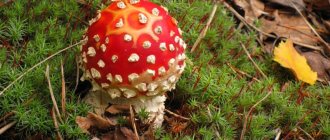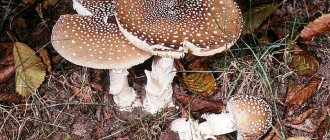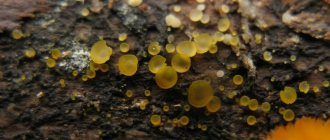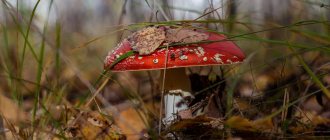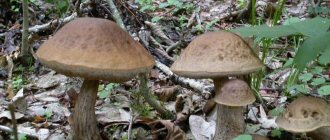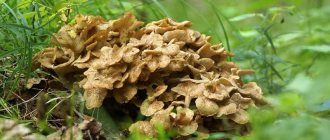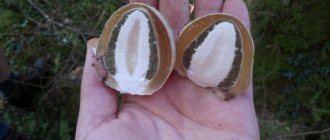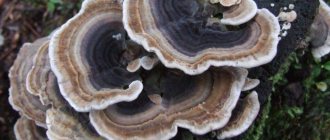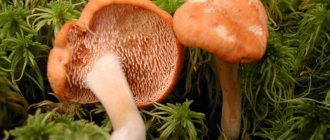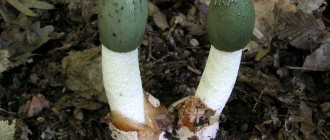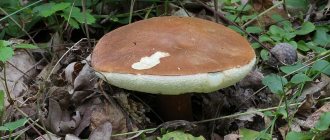The red cap seems to signal the danger of the fly agaric, and the characteristic white spots on it do not allow this mushroom to be confused with others. The red fly agaric is a very unusual mushroom. In Asia and many European countries, it has been used since ancient times as a medicine, and in some regions they still believe in the magical powers of fly agarics. This is perhaps the most famous hallucinogenic mushroom, which can cause severe poisoning.
general characteristics
Fly agaric is a poisonous hallucinogenic mushroom that has medicinal properties in microdoses, but is deadly in large quantities. Fly agarics are common in the forests of Europe, Asia, and North America. There are especially many “magic mushrooms” in Siberia and the British Isles. In ancient times, fly agarics soaked in honey or milk were left on windows as protection against insects. Hence the name of this bright mushroom.
Content:
- general characteristics
- Chemical composition
- Beneficial features
- Use in alternative medicine
- Traditional medicine recipes
- Use in cosmetology
- Use in everyday life
- How to properly collect and prepare
- Harm and side effects of fly agarics
- Fly agarics in ancient cultures
The red fly agaric belongs to the Amanita family, which includes the deadly toadstools and bisporigera. This colorful mushroom tolerates cold well. It appears in the forests in July and bears fruit until frost. Most often, fly agarics grow in symbiosis with birch, pine, spruce, and fir trees. Their bright cap with white speckled warts can grow up to 8-20 cm in diameter, and wide white plates are clearly visible under it. The leg of fly agarics is white and tall (from 5 to 20 cm); there is almost always a ring at its base. It is worth noting that the red color is not always present on the caps of fly agaric mushrooms: after rain or in old mushrooms, the bright pigment is partially or completely lost.
MUSHOMOR RED
Cap: 8-20 cm, almost spherical, then flat-rounded to prostrate, from orange to scarlet or bright red, very rarely almost yellow, usually becomes somewhat lighter with age, on the surface with white or slightly yellowish warts (remnants of the veil) irregularly rounded, mucous in wet weather. In young mushrooms, flakes on the cap are rarely absent, but in old ones they can be washed off by rain. In mature and old specimens, the edge of the cap is noticeably striped. The plates are white, slightly yellowing with age, thick, quite frequent, widened in front, with an uneven edge. The pulp is white, yellowish under the skin of the cap, with a pleasant smell and taste. White and other color forms are known.
White uniform
Yellow form (Amanita muscaria var. formosa)
Cap color options: red, white, yellow, peach.
Leg: 10-20 x 2-3.5 cm, white or yellowish, cylindrical, tuberous-swollen at the base, dense, slightly striped at the top. The tuberous thickening is covered with several rows of protruding, flocculent, white warts arranged in concentric circles. The ring is white, with a yellowish edge, very soft, sagging with age.
Habitat: in forests of any type, forms mycorrhiza with various types of coniferous and deciduous trees.
Fruiting period: June-October.
Distribution in the Russian Federation: throughout the forest zone.
Edibility/toxicity, hallucinogenicity. The red fly agaric is a cosmopolitan mushroom found on all continents except Antarctica. Its source region is the deciduous and coniferous forests of the temperate and boreal zones of the Northern Hemisphere, as well as the alpine mountain belts in warmer regions (for example, the Hindu Kush, the mountains of the Mediterranean and Central America).
Molecular studies in recent years have shown that the hypothetical place of origin of the species is the vicinity of the Bering Sea (Siberia), and this happened in the Cenozoic period, about 20-30 million years ago.
From this springboard, the red fly agaric launched into Asia, Europe and North America. Having “caught” on pine seedlings, in the 20th century the red fly agaric “moved” to the southern hemisphere, including Australia, New Zealand, South Africa and South America.
The insecticidal properties that have been attributed to the red fly agaric for almost a thousand years (at least there are definitely written sources of the 12th century, where the “fly agaric” of the fly agaric is already mentioned), and because of which the mushroom got its name in many languages of the world, on the border of our have been questioned for thousands of years. And, as it turned out, it was justified.
After conducting a series of observations and experiments, it turned out that, contrary to popular belief, flies die not due to exposure to substances contained in fly agaric, but for another reason. In the forest, the cap of an adult fly agaric becomes concave, and rainwater collects in it.
The fly agaric alkaloids dissolve well in this water, and flies, after drinking this water, after a few minutes become drunk, fall asleep and simply drown.
The same thing happens when fly agaric is crushed in a saucer with water or milk and placed indoors. If you quickly transfer a sleeping fly to a dry surface, then after 10–12 hours it wakes up and flies away.
Red fly agaric poisoning is usually recorded in young children who have tried beautiful mushrooms, and in people who use mushrooms to obtain a hallucinogenic experience. Much less often, poisoning occurs due to the fact that very young, still white, spherical red fly agarics are confused with puffballs, and mature ones with white flakes washed away by the rain are confused with the edible Caesar fly agaric (A. caesarea).
The mushroom contains muscimol and ibotenic acid. The active dose for an adult (i.e. the dose at which the first signs of mycoatropine syndrome begin to appear) is approximately 6 mg of muscimol or 30-60 mg of ibotenic acid, which corresponds to one large fresh cap.
The amount and ratio of chemical compounds in red fly agaric varies widely from region to region and from season to season.
For example, spring and summer mushrooms contain up to 10 times more ibotenic acid and muscimol than autumn mushrooms, and Siberian fly agarics have the highest concentration of alkaloids compared to mushrooms from other regions.
The lethal dose is calculated conventionally and is at least 20 fresh fruiting bodies. The only fatal case of red fly agaric poisoning was recorded in a child in the United States at the end of the 19th century.
The North American Mycological Association reported at the beginning of the 21st century that during the 20th century, not a single person died from eating red fly agaric.
Taking into account the development of modern medicine, deaths from poisoning with this mushroom do not occur.
And although many traditional publications list the red fly agaric as "deadly", this is incorrect, since they present the red fly agaric as much more toxic than it actually is.
The active components of this fly agaric are water-soluble and go into solution when boiled. When draining the broth, they are removed. Repeated boiling (2-3 times) with draining of the broth or prolonged drying followed by soaking and boiling (during drying, toxic ibotenic acid is almost completely converted into muscimol) allows you to obtain a completely edible red fly agaric. This is indicated by many modern authors and verified by me from personal experience.
Red fly agaric is well known for the unpredictability of the consequences of its consumption. Depending on the place of growth, the amount of mushrooms eaten, the general condition of the poisoned person and even his psychological mood, symptoms can vary from mild nausea, chills or drowsiness to a decrease in blood pressure, increased sweating and salivation, the occurrence of auditory and visual distortions, mood changes, the appearance of euphoria, relaxation and loss of balance.
In cases of serious poisoning, red fly agaric causes a delusional state characterized by confusion, hallucinations and increased irritability. Convulsions and even coma may occur.
Symptoms usually appear about 30 to 90 minutes after eating the mushrooms and peak within three hours (although some effects can sometimes last for several days). In most cases, restoration of normal well-being occurs within 12-24 hours.
Unlike psilocybin-containing mushrooms, the hallutinative effects of red fly agaric are not considered too attractive for recreational use,[1] primarily due to the unpredictability of the effects.
The effect of psychoactive components can be both sedative, sedative, hypnotic, and stimulating, with the appearance of hallucinations and paradoxical effects, for example, living many lives or the occurrence of macro- and micropsia (perception of oneself as significantly decreased or increased in comparison with the surrounding world; this phenomenon is vivid described by L. Carroll in “Alice in Wonderland” using the example of Alice’s meeting with a mushroom and a caterpillar).
However, after the ban on psilocybin mushrooms in many countries around the world, the recreational use of fly agaric mushrooms has increased significantly since the beginning of the new millennium.
Professor Maria Gimbutas, a renowned Lithuanian historian, reports the ritual use of red fly agaric infused with vodka in remote areas of Lithuania at wedding feasts. In addition, it is known that Lithuanians export dried fly agaric mushrooms to the Far North for the Sami, for their use of mushrooms in shamanic rituals. Lithuanian holidays are the only mysteries with the use of fly agaric known in Eastern Europe.
Red fly agaric was (and continues to be) widely used as an entheogen by many indigenous peoples of Siberia. Its use in rituals was known among almost all Ural-speaking[2] peoples of Western Siberia and Paleo-Asian-speaking[3] peoples of the Russian Far East.
There are only isolated reports of the use of fly agaric among the Tungus and Turkic peoples of Central Siberia, and it is believed that, in general, the entheogenic use of fly agaric is not practiced by these ethnic groups.
In Western Siberia, the use of fly agaric was the prerogative of shamans, who used it as an alternative method of achieving a state of trance (in ordinary cases, Siberian shamans achieved a state of trance through long dances).
In Eastern Siberia, fly agarics were used by both shamans and ordinary people, both for ritual and mystical purposes and simply for entertainment. It was in Eastern Siberia that the tradition arose of drinking the urine of a person who had eaten fly agaric, since the effect of urine containing psychoactive elements can be more powerful than that of the fly agaric itself, and without such unpleasant additional “fly agaric” effects as sweating and twitching of the limbs (i.e. e. it turns out that the original user acts as a kind of molecular filter for the unfavorable components of the fungus).
Meanwhile, it is known that among the Koryaks, fly agarics themselves were eaten by rich people who could afford to buy fly agarics from a shaman (independent collection was categorically taboo, only shamans could do this), while the poor Koryaks were forced to consume the fly agaric urine of the rich. This suggests that the degree of purity of the hallucinogenic components and the absence of adverse effects did not play any role compared to the possibility of eating the mushroom itself.
The use of fly agarics depended on the customs of the tribe. Up to 15 such methods are known - they were eaten raw, fried, baked, dried, extracts and decoctions were prepared, and the meat of reindeer that had eaten mushrooms was consumed. In shamanic rituals, old fruiting bodies were used, while hunters were given young unopened caps, peeled from the skin, which contains the largest amount of active substances, to increase endurance.
Three stages of fly agaric intoxication during ritual use are described, which can occur separately or sequentially during one dose.
- At the first stage, characteristic of young people, pleasant excitement sets in, causeless noisy gaiety sets in, agility and physical strength increase.
- At the second stage, hallucinogenic effects appear, people hear voices, see spirits, the entire surrounding reality takes on a different dimension for them, but they are still aware of themselves and react normally to familiar everyday phenomena, and can answer questions meaningfully.
- The third stage is the most severe: a “fly agaric” person enters a state of altered consciousness, he completely loses touch with the surrounding reality, is in the illusory world of spirits and under their power, but he is active for a long time, moves and speaks, after which a heavy narcotic sleep sets in.
There is a hypothesis that soma, the sacred drink of the Aryans, was prepared using the red fly agaric. The Vikings supposedly used berserkers and ulfhednars to enter a combat trance.
As mentioned above, the toxins of the red fly agaric are soluble in water. Being thinly sliced and boiled with the decoction drained, fly agaric mushrooms prepared in this way become normal edible mushrooms. Although eating detoxified red fly agaric has never been widespread, it is now quite common in some countries in Europe (not just Russia) and Asia. Back in 1823, the German doctor and naturalist Georg Heinrich von Langsdorff compiled a description of how to protect the red fly agaric.
In the late 19th century, French physician Felix Archimedes Pouchet popularized and advocated the use of fly agaric, comparing it to cassava,[5] an important food source in tropical South America, which also had to be detoxified before consumption.
The use of this mushroom as a normal food source is also known in North America. A classic example is the description of a black merchant distributing specially prepared red fly agarics in Washington, D.C., compiled at the end of the 19th century by the American botanist Frederick W. Coville.
In this case, the mushroom, after steaming and soaking in grape vinegar, was sold as mushroom sauce for steaks.
From ancient times to the present day, red fly agarics have been eaten in some areas of Japan. They are best known for their use as a traditional edible mushroom in Nagano Prefecture, primarily in salted and pickled form.
A striking example of the changing attitude to the toxicity of the red fly agaric is a 2008 article by culinary historian William Rubel and mycologist David Arora, which outlines historical information about the use of fly agaric as food and provides all known methods of detoxification [6].
The authors advocate that the red fly agaric mushroom should be described in field guides as an edible mushroom (although accompanied by instructions on how to neutralize the toxins). The authors argue that the mushroom's widespread toxicity in field guides reflects cultural bias, as is the case with a number of other popular edible species, such as morels.
Medicinal properties: throughout the European part of Russia, red fly agaric has been traditionally used for many centuries not only to prepare a liquid for killing flies, but also as a medicinal mushroom. Infusions and compresses from this mushroom help with wound healing, bruises, rheumatism, stomach diseases, diseases of the nervous system, gland tumors, tuberculosis and a host of other diseases.
The results of biochemical experiments showed that the skin of the red fly agaric cap contains the antibiotic substance muscaruphine, a fiery orange pigment that inhibits the development of tumors. The pulp of the mushroom also has valuable medicinal properties. Even Paracelsus in the 16th century. recommended red fly agaric as a good remedy for diabetes and for the prevention of tuberculosis.
From red fly agarics, folk healers, and later certified doctors, learned to make drugs for those suffering from spasms of blood vessels, cerebral sclerosis, chronic tonsillitis and such serious diseases as chorea and epilepsy, various forms of cancer and tuberculosis. These drugs have also passed pharmacological tests, but have not gained a foothold in official medicine everywhere, due to the high toxicity of the starting material. Meanwhile, preparations from fly agaric and its medical use are legal in many countries of the world: the USA, Canada, Great Britain, Denmark, Norway, the Netherlands, Italy, Finland, Russia, Japan, New Zealand.
Red fly agaric is very widely used in homeopathy. In this type of alternative medicine, the mushroom is indicated for almost all existing diseases. For more detailed information, I refer you to the book “Treatment with fly agaric mushrooms” by T.V. Makeenko, which provides recommendations from homeopathic doctor T.D. Popova.
It is difficult to say where people got the knowledge about the healing properties of fly agaric. Maybe from observing wild (elk, deer) and domestic ungulates, which are undoubtedly treated with fly agarics. Squirrels, bears and magpies also crack the fly agaric on both cheeks. I have heard several reliable stories about sick cows that were fed fly agarics until they completely recovered (one was cured of worms, another was cured of something very complex). Many modern veterinarians add crushed fly agarics to feed intended for sick animals, believing that such treatment helps much better than medications.
It is reliably known that it was the Slavs who primarily used fly agarics for healing. Even in Siberia, fly agaric was used as a medicinal mushroom by newcomers from beyond the Urals and people from the Far North, and not by local residents and certainly not by shamans. There is simply no information about the existence of a long-standing medicinal practice based on one or another use of fly agaric among the indigenous peoples of Siberia. Quite the contrary, it seems that the current infrequent medicinal use of fly agaric was borrowed by them from the Russians. And at present, the medical use of red fly agaric is limited mainly to Eastern Europe.
It is interesting that in the old days, Russian healers used only the lower part of the stem of the still immature fly agaric in fresh form, and the other parts were dried and made into powder. Here we can draw a parallel with the Mexican mescaline-containing hallucinogenic peyote cactus (Lophophora williamsii), the highest concentration of active alkaloids of which is concentrated precisely in the lower part of the stem and the upper part of the turnip root.
Externally, fly agarics are usually taken in the form of an ointment or infusion and are used to treat ulcers, abscesses, burns and frostbite, external tumors and cancerous ulcers, skin diseases, including eczema. Ointments and infusions also help with pain in muscles, bones, joints, lower back and salt deposits, and with many eye diseases.
People use fly agaric externally with ease, as it gives a good and reliable healing effect. For example, fly agaric has very strong wound-healing properties. You can take fresh fly agaric mushrooms, tear off only the caps from them, knead them and use gauze to bandage the finished mass to the wound. After a couple of hours, the skin wound will begin to heal. Externally, fly agaric is used for spots in the eyes, decreased vision, conjunctivitis, inflammation of the eyelid margins, myopia and cataracts. Pain in the ears, itching in them and swelling of the ears can also be cured with the help of preparations from fly agaric.
Internal use of fly agaric is used not only in folk medicine, but also by homeopathic doctors. In folk medicine, if fly agaric is used internally, it is used “for everything.” This is a real panacea, possessing all the necessary universal healing properties, from general strengthening to curing all diseases and granting longevity. For internal use, use an infusion of alcohol or vodka.
I could give a list of diseases that can be cured by taking fly agaric orally, but it’s easier to buy a thick medical reference book and read it a couple of pages at night. The list of recipes would be no less thick, and the list of evidence of real cases of successful treatment through fly agaric would be even more enormous.
As an example, I can give the following range of indications: toothache, belching, increased salivation, prickly pain in the heart, bad breath, inappropriate behavior, sclerosis, paralysis, heaviness in the stomach, gas, bloating, constipation and diarrhea, impotence, painful menstruation, sexual arousal and genital irritation.
In many countries, including Russia, preparations from fly agaric are used in official medicine.
[1] Recreational use of psychoactive substances is the periodic use of psychoactive substances, not related to medical indications, for pleasure or other purposes. This use is often associated with the social activity of the individual; typical examples are the use of psychoactive substances at parties and clubs.
[2] The Uralic languages are a language family that includes two branches - Finno-Ugric and Samoyed.
[3] Paleo-Asiatic languages is a collective term for languages in northern and northeastern Siberia and the Far East, not related to each other by genetic kinship and preserved in Northern Asia from times before the widespread use of Tungus-Manchu languages there. Paleo-Asian languages include the Yenisei, Chukchi-Kamchatka and Yukaghir languages.
[4] Berserkers are warriors who believe themselves to be bears in a combat trance, Ulfhednars are wolves.
[5] Edible cassava or cassava (Manihot esculenta) is an important edible tropical root plant of the Euphorbiaceae family. Originally originating from South America, it is now cultivated in many tropical regions of the Earth with a suitable climate. Raw cassava roots contain the cyanogenic glycosides linamarin and lotaustralin, and depending on the concentration of these glycosides in the plant, cassava varieties are divided into bitter (with a high concentration of cyanogenic glycosides) and sweet (actually just non-bitter). The dose of hydrocyanic acid contained in 400 grams of unprocessed bitter cassava is lethal for humans. The consequences of mild poisoning due to long-term consumption of insufficiently pure raw materials are ataxia (impaired coordination of movements of various muscles) and amblyopia (decreased vision that cannot be corrected); incurable types of paralysis occur in children. The seeds of some varieties act as a laxative and cause vomiting. Traditionally, cassava roots are cleaned, mashed or crushed, soaked and boiled, which significantly reduces the cyanide content. An alternative method was proposed by Howard Bradbury: ground cassava mixed with water is placed in a thin layer of 1 cm in the shade, where it dries for 5–6 hours. This results in almost complete evaporation of the cyanide. Agree, the analogy with the red fly agaric is almost complete: either grinding and boiling, or drying.
[6] Rubel W., Arora D. (2008). "A Study of Cultural Bias in Field Guide Determinations of Mushroom Edibility Using the Iconic Mushroom, Amanita Muscaria, as an Example." Economic Botany 62(3):223–43.
Chemical composition
The chemical composition of the red fly agaric has not yet been studied enough. Based on the information that scientists have today, we can say that the mushroom contains chitin, essential oils, xanthine, betanin, choline, muscarufin pigment, trimethylamine, puterescine, as well as poisonous alkaloids: ibotenic acid, muscarine, muscaridine, muscimol. Fly agaric contains several psychoactive substances at once and they are all concentrated in the mushroom cap, or more precisely, in its red film.
For many years, muscarine was considered the active hallucinogenic agent. And only in the 1960s, two scientists from Japan and Switzerland independently, but almost simultaneously, determined that ibotenic acid and muscimol actually have a hallucinogenic effect. And muscarine, entering the human body in large quantities, can cause poisoning, accompanied by a sharp decrease in blood pressure, respiratory failure, constriction of the pupils and weakening of the pulse. A lethal dose of muscarine is contained in 3 kg of fly agarics.
Most of all the mushroom contains muscimol. This is the main active ingredient of these mushrooms, which has pronounced sedative, hypnotic, dissociative and psychoactive properties. To minimize the toxic effect, mushrooms should be dried. But you should know that in this form the concentration of hallucinogenic substances in the product increases.
Contraindications
Contraindications include:
- increased sensitivity to the components that make up the fungus;
- pregnancy;
- lactation period;
- disorders of the nervous system.
Uncontrolled use of fly agaric can lead to side effects and death. The mushroom is beneficial if consumed in the indicated dosages.
In everyday life, the mushroom is used as a means to combat insects. A special decoction is prepared for this. Add 6 fly agarics to 1 liter of water. Bring the liquid to a boil and remove from heat. After cooling, the broth is added to a spray bottle and sprayed on walls and furniture. The fly agaric remedy will help get rid of cockroaches and ants. In advanced cases, re-treatment will be required.
Beneficial features
In pharmacology, red fly agaric extract is used to create drugs against sore throat, epilepsy, arthritis, psoriasis, dermatitis and fungi. Remedies from fly agarics help with varicose veins, papillomas, they treat pathologies of the spinal cord, bedsores, vascular spasms, and boils. Depending on the concentration, medicines with mushroom extract can be used externally and orally.
People with cardiovascular diseases can feel the benefits of red fly agarics. In particular, there is an opinion that the extract of these mushrooms has a beneficial effect on people with coronary heart disease, hypertension, and atherosclerosis. The same mushroom is believed to be beneficial for diabetes and impotence. For the female body, the extract of “magic mushrooms” is also a good helper in some cases. For example, with painful menstruation or during menopause.
French researchers have confirmed that the correctly chosen dosage of red fly agarics affects the body as a sedative, reduces nervousness, anxiety and reduces the effects of stress. Therefore, mushroom extract is often added to anti-insomnia medications. In addition to the French, the Dutch, Finns, Norwegians, British, Japanese, and Italians use fly agaric. Preparations containing mushroom extract are allowed in New Zealand, Denmark, Switzerland, the USA and Russia, but in Australia and Israel the use of fly agarics in medicine is prohibited.
Some researchers consider red fly agarics as an antitumor agent. True, there is no irrefutable evidence of this fact in official science yet. Creams with mushroom extract are useful for the treatment of varicose veins, arthritis, arthrosis, osteochondrosis, and gout.
How to use preparations from fly agarics?
Buying fly agarics and using them according to the scheme is half the battle. The main thing is to develop an individual algorithm for using fly agarics in such a way as to get the maximum benefit! This can only be done through the practical use of fly agarics. This is why the methodology itself exists, micro-supply of the active substance of fly agaric into the human body.
You need to start therapy with a minimum dosage of the drug. It is: 0.5 grams of substance at a time. Twice a day, 0.5 grams is enough to resolve the issue of allergic reactions of the body to Amanita muscaria preparations. If this is not detected, you can safely increase the dosage to 1 gram/2 times a day. The recommendations of “experienced adherents” agree that a beginner should purchase powder microdosing of the Red Amanita. A beginner must learn how to use a scale. Be able to make the exact dosage for yourself, avoiding the uncertainty of “fly agaric caps” or “sent variants” of gelatin capsules. It’s safer and more effective this way!
Having measured out the prescribed amount of powder, it is sent to the mouth, washed down with water or sweet juice. The juice activates the components of fly agaric in the body - enhancing the absorption of mushrooms in the human gastrointestinal tract. A small but very useful nuance! It is better to eat fly agarics and use their powder or other forms of fly agarics shortly before meals (20 minutes), or shortly after taking them. It's a matter of taste! By the way, the taste of fly agarics is quite pleasant, although a bit dry. It is taken easily and without “nauseating plugs”.
Regarding the number of doses of the drug per day: 1-2 or three times, 1 gram or 1.5 grams is quite optimal for a beginner. You need to prepare yourself for long-term microdosing, since the first signs of the action of active substances may not appear very soon. That's why it's Microdosing Amanita muscaria! All in very small quantities and imperceptible impact. Therefore, it is considered a dietary supplement that is safe for food use.
Use in alternative medicine
Microdoses of fly agarics are used in alternative medicine as a medicine against nervous disorders. But it’s worth saying right away that raw or not specially processed fly agaric mushrooms are never used for medicinal purposes. Fresh mushrooms contain a dangerous poison that has a detrimental effect on the liver.
Some find these mushrooms useful for treating chronic dizziness, Parkinson's disease and dementia. In addition, in alternative medicine, these red mushrooms are used as a medicine against nervous tics, depression, and to treat cerebral disorders.
In homeopathy, fly agaric is used for excessive excitability, bladder diseases, and intestinal spasms. Such drugs are considered beneficial for the female body during menopause.
Fly agaric has anti-inflammatory, bactericidal and antiseptic properties. Therefore, mushroom extract is added to wound-healing creams, which are useful for burns, frostbite, ulcers and some other skin diseases.
Conclusions on the rules for using fly agarics
- Collect raw materials (fly agaric mushrooms) in places far from the city and industrial zones;
- Dry mushrooms before eating;
- Do not take mushroom preparations (except microdosing) while conducting daily activities (study, business, career);
- Do not spread among your friends, colleagues and neighbors about your experiments with mushrooms. Why do you need the notoriety of the “Mushroom King”?
- Be responsible and understanding Warriors of the Path, but not idiots lost in the mushrooms!
Traditional medicine recipes
Traditional healers have been using the medicinal properties of the “magic mushroom” for many centuries. Many of the ancient recipes have survived to this day. We have selected the most popular of them. But do not forget, any medicine made from fly agarics has toxic properties. After preparing or using tinctures, be sure to wash your hands well. And finished drugs should be kept away from children.
For dermatitis
To treat various kinds of skin diseases, folk healers resorted to the help of fly agarics. To prepare the medicinal tincture, no more than 5 mushrooms were used. They were finely chopped and placed at the bottom of a liter jar. The vessel was closed and sent for 3 days in a warm but dark place. During this time, the mushrooms should release juice. On the fourth day, vodka was added to the vessel (about 1 cm above the mushrooms) and left for another 3 weeks. The prepared product was used to wipe the skin affected by the disease. Do not apply the product to large areas at once. Treatment should begin with small areas so that the fly agaric extract does not cause allergies.
For varicose veins
As in the previous recipe, 5 fly agaric mushrooms should be crushed and left in a glass vessel until mushroom juice forms. Drain the resulting juice and squeeze the pulp into a separate container. Dilute the juice squeezed from the mushrooms with warm water (in a 1:1 ratio). Wipe the sore areas with the resulting product twice a day, then wrap it with an elastic bandage. The juice squeezed from mushrooms can be stored in the refrigerator for no longer than 4 days. The medicine should be diluted with water immediately before applying to the skin.
How to prepare the medicine yourself?
To prepare tinctures, it is recommended to collect them in an ecologically clean region, since the fruits can absorb all toxic substances from the environment. The fly agaric should be beautiful and undamaged. It is used to prepare medicines for various ailments. It is recommended to use disposable vinyl gloves for collection. To dry the mushrooms, they should be pressed slightly, placed on clean paper and placed in a place protected from direct sunlight. Drying fly agarics in an oven is strictly prohibited. To prepare the medicine, a glass container and a wooden board are used, which are disposed of at the end of the work.
Preparation method No. 1: alcohol tincture
To prepare a mushroom tincture of 50% concentration, you need to take the caps of young fruits, lightly dry them and spread them over tissues in a dry and dark room.
Every other day, they are cleared of debris, grass, leaves, cut into small pieces, weighed and mixed with vodka in a one-to-one ratio. The glass jar with the tincture is closed with a lid and placed in a dark, cool place for a month, after which it is filtered and the resulting red liquid is used for its intended purpose. To reduce the concentration by half, the tincture is diluted with vodka in a ratio of one to one.
Cooking method No. 2: fermentation of mushrooms
According to an ancient recipe, fruit tincture is prepared in several stages:
- Only collected mushrooms are cleaned of dirt.
- Cut into small pieces.
- Fill the bottle with them and close it.
- The container is buried in the ground to a depth of about one and a half meters.
- After a month, the mushrooms ferment and release their juice.
- The juice is diluted with vodka in a one to one ratio.
Important! You should be aware that the resulting product has an unpleasant specific odor.
Preparation method No. 3: tincture of dried fly agaric
In winter, you can prepare a tincture from dried fruits. At the same time, the beneficial properties of fly agaric do not decrease at all. The ingredients you will need are 100 g of dry raw materials and 1000 ml of vodka, mixed in a dark glass jar. Infusion time: 3 weeks.
Cooking method No. 4: finely chopped mushrooms
This recipe has been used for a long time in the treatment of cancer. You need to take four medium-sized fruits, chop them very finely (to the point of caviar), place them in a glass container and pour vodka (0.5 l). After a month of infusion, the finished medicine must be strained.
Use in cosmetology
Fly agaric extracts used in pharmacology or cosmetology contain practically no toxins. On the contrary, they are rich in beneficial enzymes, polysaccharides and antioxidants with high bioactivity. Red fly agaric extract is beneficial for skin care. This product promotes the production of collagen and the regeneration of skin cells, makes it firm and elastic, smoothes out fine wrinkles, improves complexion by lightening age spots. In addition, creams containing fly agaric extract are useful for combating cellulite and stretch marks on the skin. By the way, creams containing the extract of these mushrooms will also help get rid of calluses and cracks on the skin of the feet.
What foods contain glucosamine and chondroitin?
Before talking about what products to use to compensate for the deficiency of glucosamine and chondroitin, you need to have an idea of what joints are made of.
Any joint in the body is formed by at least two bones. The contact points are covered with articular cartilage, which, like a sponge, has a cellular structure. The space between the cartilages is filled with synovial fluid. It consists of a liquid part - blood plasma, and a protein part - chondroitin, glucosamine, hyaluronan.
When a person moves, cartilage acts like a sponge: fluid from the deep layers of cartilage penetrates between the fibers and lubricates the articular surface. When the load decreases, the fluid flows back into the cartilage. With this mechanism, friction between bones is reduced and their strength is maintained.
In order to restore the osteoarticular system, special preparations have been developed - chondroprotectors, which include glucosamine and chondroitin. In addition to medications, for proper joint function, you need to take vitamins and microelements and eat the “right” foods. Chondroitin and glucosamine are found in small quantities in almost all products, but they are bound in the structure of polymers, so their digestibility is low.
The main substances from which these substances are well absorbed are:
- cartilage;
- white meat;
- hard cheeses;
- beef;
- fish of the sturgeon and salmon families;
- dairy products;
- butter;
- vegetables;
- fruits;
- gelatin dishes: jellied meat, jelly;
- legumes;
- nuts and dried fruits;
- eggs;
- linseed oil.
Harm and side effects of fly agarics
Amanitas are extremely toxic. Eating raw mushrooms can cause liver and kidney failure, and if consumed in large quantities, can be fatal. Signs of poisoning appear an hour after eating poisonous mushrooms, and reach their peak after 3 hours, although some side effects may persist for 10 hours. Mushroom poisoning is accompanied by nausea, vomiting, diarrhea, severe salivation, dilated pupils, confusion, and excitability. If a person receives medical attention on time, there is a chance of recovery within the next 12 hours. In case of fly agaric poisoning, you should rinse your stomach as quickly as possible, drink a laxative (30 g of magnesium sulfate per 100 ml of water) and call an ambulance.
Do not exceed the dosage of medications containing fly agarics. Even in microdoses, products with mushroom extract are prohibited for pregnant women, nursing mothers, children, people with gastritis, stomach ulcers, liver, pancreas or duodenal dysfunction.
Benefit for health
Let's talk about using the mushroom for preventive and health purposes. As already noted, heat treatment allows you to obtain a completely safe product.
For example, after fine grinding, fly agaric is used for:
- prevention of cancer;
- in case of disorder of the digestive system, gastrointestinal tract;
- the product reduces pain in the muscular system due to back and joint pain;
- increasing the body's immune defense, improving resistance to bacteria and viral infections with regular consumption of ground food.
Red mushroom is included in the category of adaptogens, which allows it to provide anti-stress functions, tone the body after physical activity, and effectively combat negative addictions (smoking, drugs, alcoholism). Treatment with fly agaric can also take place in the form of tinctures and special decoctions.
Let's look at the key features of their use:
- the product acts as a powerful natural antidepressant;
- normalization of the human brain;
- analgesic effect;
- healing of shallow wounds, cuts, bruises;
- treatment of gout, eczema, neurodermatitis and so on.
The Greelife.ru store of healthy supplements offers a wide range of fly agaric mushrooms (including in the form of microdosing), as well as other types of medicinal mushrooms.
Existing varieties
More than 600 different species of fly agarics live in the surrounding world. Fly agarics grow where ordinary mushrooms do: in deciduous and coniferous forests, they are found even in cold regions (tundra). Along with the well-known red fly agaric, there are other varieties of it, differing in appearance and caps of red, white, green, orange and other colors.
Most often found in nature:
- Panther fly agarics. They are brown in color. Their flesh is white and the smell is unpleasant (like black radish). The size of their caps and the height of the porous cylindrical legs are in the range of 5−12 cm.
- Toadstool mushrooms (yellow pale toadstools). They have a white hemispherical cap, covered with snow-white specks, and an unpleasant odor.
- Rough fly agarics. These mushrooms have a thick stalk. They are small, fleshy, yellowish (olive) in color. When young, they have a round cap that looks like a ball; in adult specimens, it takes on a flat shape with slightly curved edges. When cut, the flesh of these mushroom specimens turns from white to yellow. Its smell, unlike other varieties, is quite pleasant.
- Royal fly agarics. These are large mushrooms with a 20 cm brown (olive) cap covered with yellow flakes. Their flesh has a yellow-brown color that does not darken when the mushroom is cut. This mushroom variety, when poisoned, can cause severe hallucinations.
- Amanita spiny-headed (fat, bristly). The round shape of the cap of young mushrooms turns into a fleshy umbrella cap of adults. It is white and covered with gray specks. A distinctive feature of these mushrooms is a white stem with a thickening in the middle, scaly at the base. The plates of adult specimens are pink. The flesh of these mushrooms is dense and the smell is pungent. Such fly agarics are highly poisonous and cause poisoning even after heat treatment.
- White stinking fly agarics. Very toxic. They are clearly different from the classic bright and spotted specimens. Their cap is white, there are no specks on it. Its diameter is from 5 to 11 cm, its shape is conical with a sharp, often deformed, tip. When broken, the cap emits an unpleasant odor similar to bleach. The stem of the mushroom reaches a height of 11−15 cm. Often located plates are gray or white.
Selection and storage
To use such mushrooms yourself, you need to know how to select and store them correctly:
- You can collect fly agarics throughout the growing season; the most useful components are in the mushroom cap, so it must be smooth, intact, and not damaged by insects;
- drying of the caps is carried out after removing the plates from their inside, by stringing the caps on a thread or in the oven at a temperature of about 50 °C;
- dried mushrooms should be stored in a dark, dry place and in a closed container;
- You need to remember about the toxic properties of fly agaric mushrooms, so preparations based on them must be stored in places inaccessible to children and pets, in labeled, closed containers.
The fly agaric has properties that are contradictory in nature. On the one hand, it is poisonous and dangerous. On the other hand, this mushroom is useful because it helps a person recover from many diseases. And taking into account the description of the fly agaric, its properties and applications, you can either admire its interesting appearance, or take advantage of its healing properties and get rid of existing ailments.
Description of the mushroom and its features
Fly agaric belongs to the lamellar mushrooms of the Amish family. The bright, elegant appearance of this forest dweller is very deceptive - it is a poisonous fungal root, which is a symbiosis of mycelium (mycelium) with the roots of various plants and trees. At the moment, there are more than 600 species of fly agarics in nature, and their color is not always bright red; the caps can be brown, yellow and white. The most famous varieties are royal, Caesar, panther, and red fly agaric.
Externally, the ordinary red fly agaric is a large, fleshy mushroom; its cap can be thinner or thicker, sometimes with a small tubercle. White flakes are located along it - these are preserved tissue segments in the process of formation. The base of the leg expands towards the ground. The ring or “skirt” in the upper part of the leg is a shell in which young individuals are enclosed; reproduction occurs with the help of spores.
Not everyone knows that the most poisonous mushroom, the toadstool, poisoning with which can lead to death, also belongs to the fly agaric family. The diameter of its cap can be 10-14 cm, the leg is high - up to 12 cm. Just a few grams of this mushroom are enough for poisoning to lead to death. A special feature of the toadstool is the presence of a filmy ring, thanks to which it can be distinguished from such similar floats, russula and champignons.
The process of absorption of substances
As noted earlier, glucosamine and chondroitin are found in a bound state in many foods and are poorly absorbed. The chondroitin sulfate molecule is a hundred times larger than the glucosamine molecule, and its bioavailability is about 15-20%. Glucosamine contains a glucose core, which, as a conductor, increases digestibility by up to 41%.
Therefore, to strengthen your joints, you first need to start eating right.
You should not self-medicate if you have complaints:
- crunch;
- pain during movements;
- morning stiffness;
- restriction of movements;
- edema;
- hyperemia of the skin over the joints.
In this case, only a specialist will individually select therapy aimed at reducing inflammation and pain, restoring the cartilage framework and, consequently, motor function.
Toxicity and precautions
Due to the fact that the substances in fly agarics are potent, mushrooms can cause harm to the body. When used in excess, the active substances of the poisonous fly agaric have a neurotoxic effect.
The neurotoxic effect is caused by the destruction of nerve cells and brain tissue under the influence of nitric oxide, a substance produced as a result of the interaction of ibotenic acid and cell receptors.
Muscarine provokes intoxication to a lesser extent. Its content in the total mass of the poisonous mushroom is very insignificant, and to correspond to the lethal dose, at least 5 kg of fresh fly agaric is needed
Signs of overdose and poisoning
Symptoms of poisoning appear quite quickly - after 0.5-2 hours.
Signs of overdose and poisoning:
- Nausea and vomiting;
- Stomach ache;
- Profuse sweating and salivation;
- Heart rhythm disturbances;
- Constriction of the pupils;
- Euphoria;
- Drowsiness;
- Impaired muscle coordination;
- Convulsions and seizures resembling epileptic ones;
- Auditory and visual hallucinations.
Fact! According to the North American Mycological Society, from 1909 to 2009, there were no deaths due to red fly agaric poisoning worldwide. Over 90% of mushroom poisonings are caused by poisonous toadstool and fly agaric.
What happens to fly agaric during processing?
Scientist and author of books about mushrooms M. Vishnevsky writes about reducing the toxicity of poisonous fly agaric after boiling mushrooms in water 2-3 times for 20 minutes. Toxic substances are not destroyed during heat treatment, they simply turn into a decoction.
Important! After each time of cooking, the liquid is drained and the mushrooms are filled with a new portion of water.
When drying fly agaric, some of the substances remain unchanged in the mushroom.
Muscarine is not destroyed and accumulates in small quantities in the caps.
When dried in the sun or exposed to hot air, some of the ibotenic acid is converted into muscinol, which is 5-10 times stronger than the original substance. Thus, dried fly agaric becomes more useful and effective, but also more toxic in case of overdose.
Precautionary measures
To avoid harm from fly agaric mushrooms, it is strictly necessary to observe the dosage, the rules of production and administration, and the shelf life.
The highest concentration of useful substances is found in the fly agaric caps. Therefore, to reduce the concentration, you can first peel the skin from the cap.
After working with mushrooms, you need to wash your hands or wear gloves.
Care should be taken to avoid contact with open wounds and damage to the skin and mucous membranes.
Contraindications to the use of red fly agaric
- Pregnancy and breastfeeding period;
- Age up to 18 years;
- Mental illnesses;
- Urolithiasis disease:
- Stomach ulcer.
Fly agaric in cosmetology
Thanks to bioactive substances based on polysaccharides, fly agaric is beneficial for skin health. Dried fly agaric powder is added to ointments and creams to obtain cosmetic effects:
- Stimulates collagen production;
- Softens the skin;
- Promotes rapid restoration of the skin;
- Improves complexion;
- By accelerating metabolism, they help get rid of cellulite;
Why does fly agaric have a psychogenic effect?
The effect of fly agaric on the nervous system is due to three main substances - ibotenic acid, muscinol and muscarine. The first two penetrate the blood-brain barrier (BBB), a protective structure between the circulatory and nervous systems. Having crossed the BBB, the substances affect the nerve cells of the brain. Ibotenic acid has an stimulating effect, and muscinol has an inhibitory effect.
The psychogenic effect manifests itself individually and depends on the type of nervous system, the concentration and ratio of substances in poisonous fly agarics.
